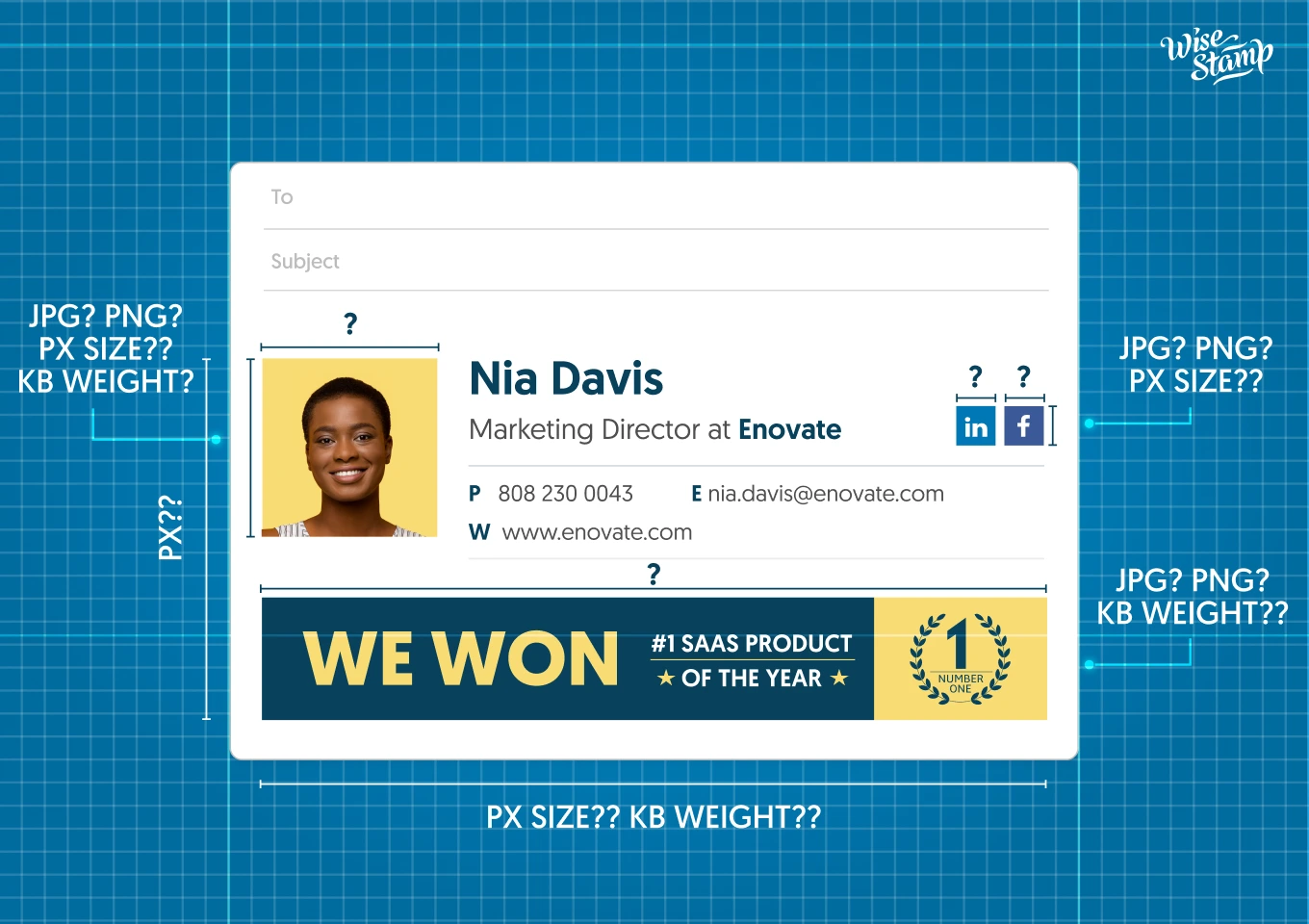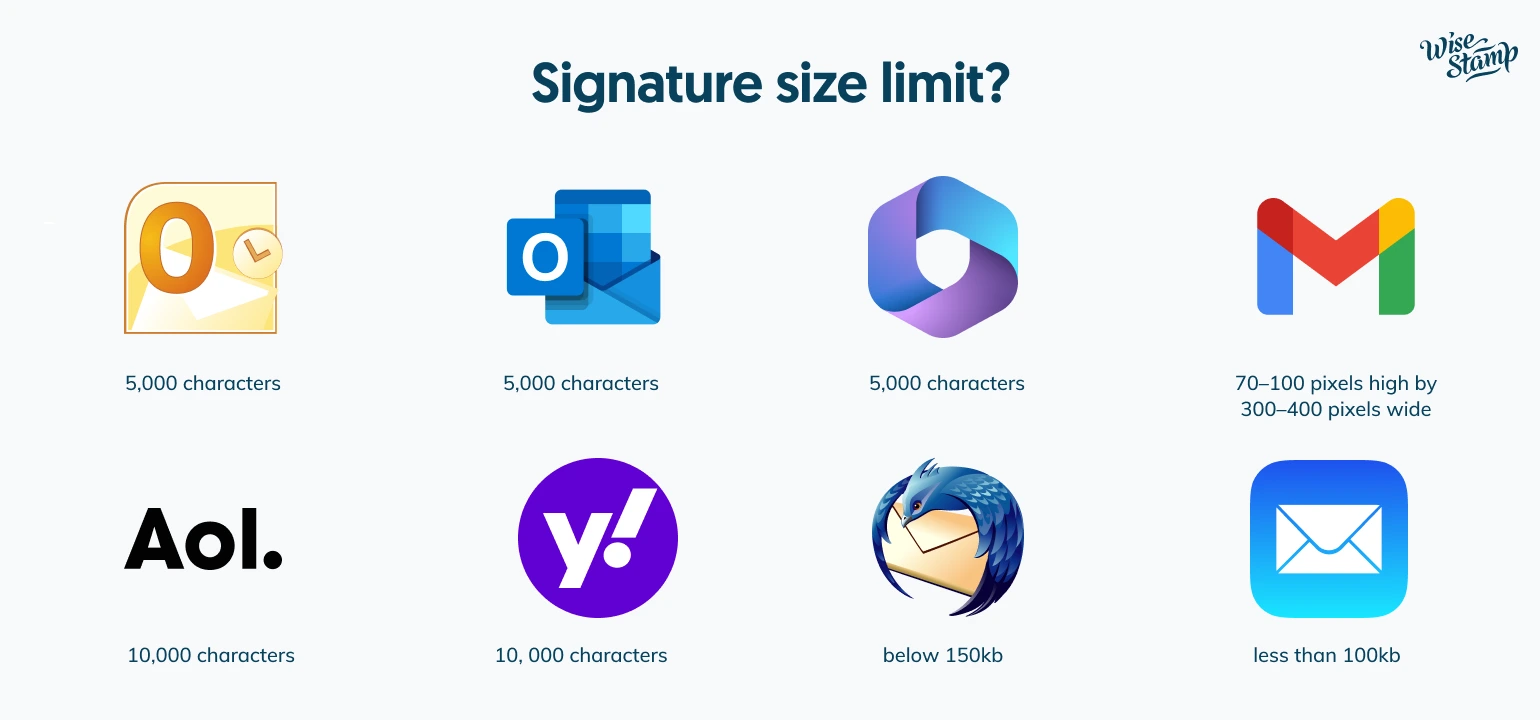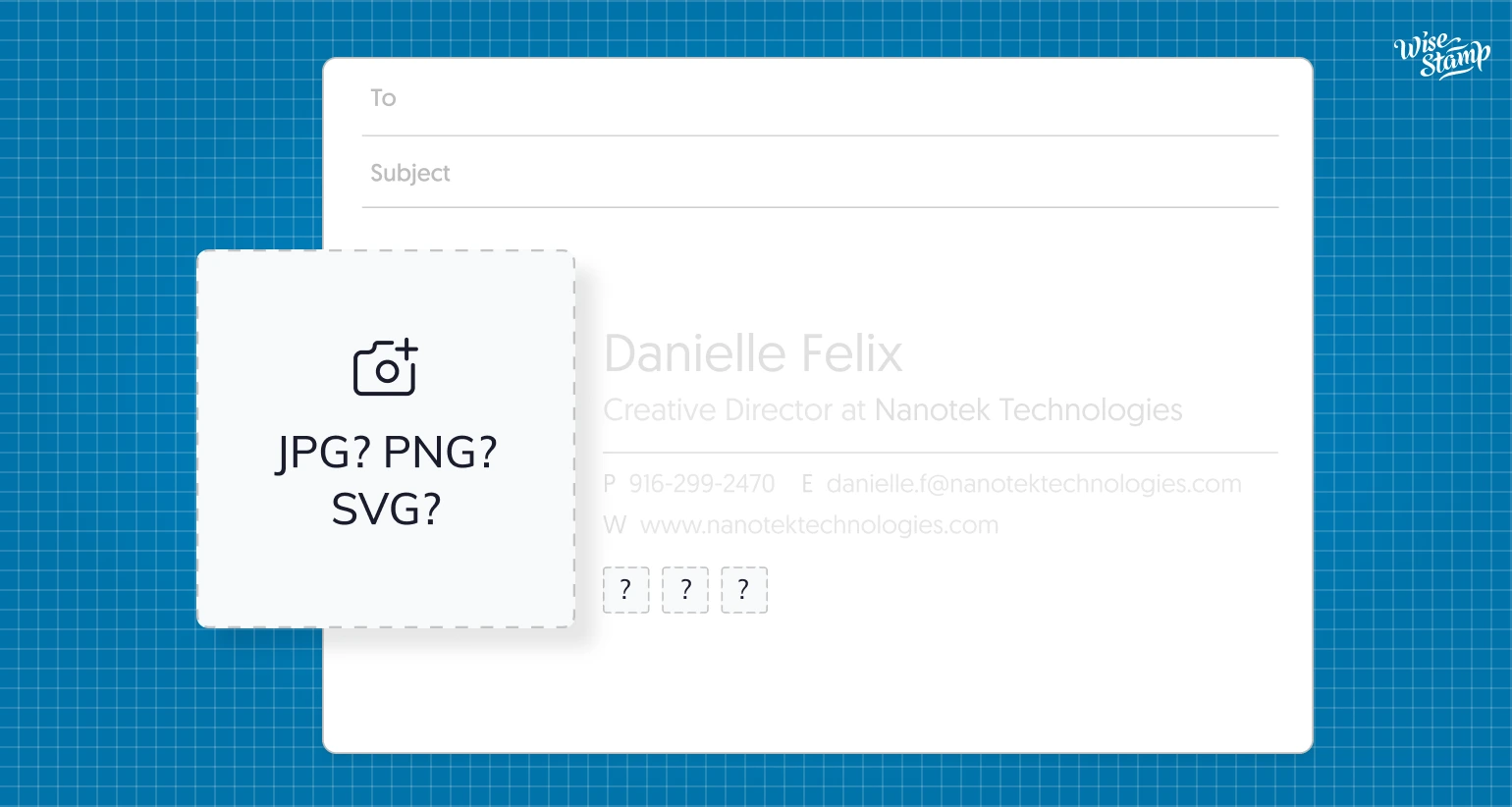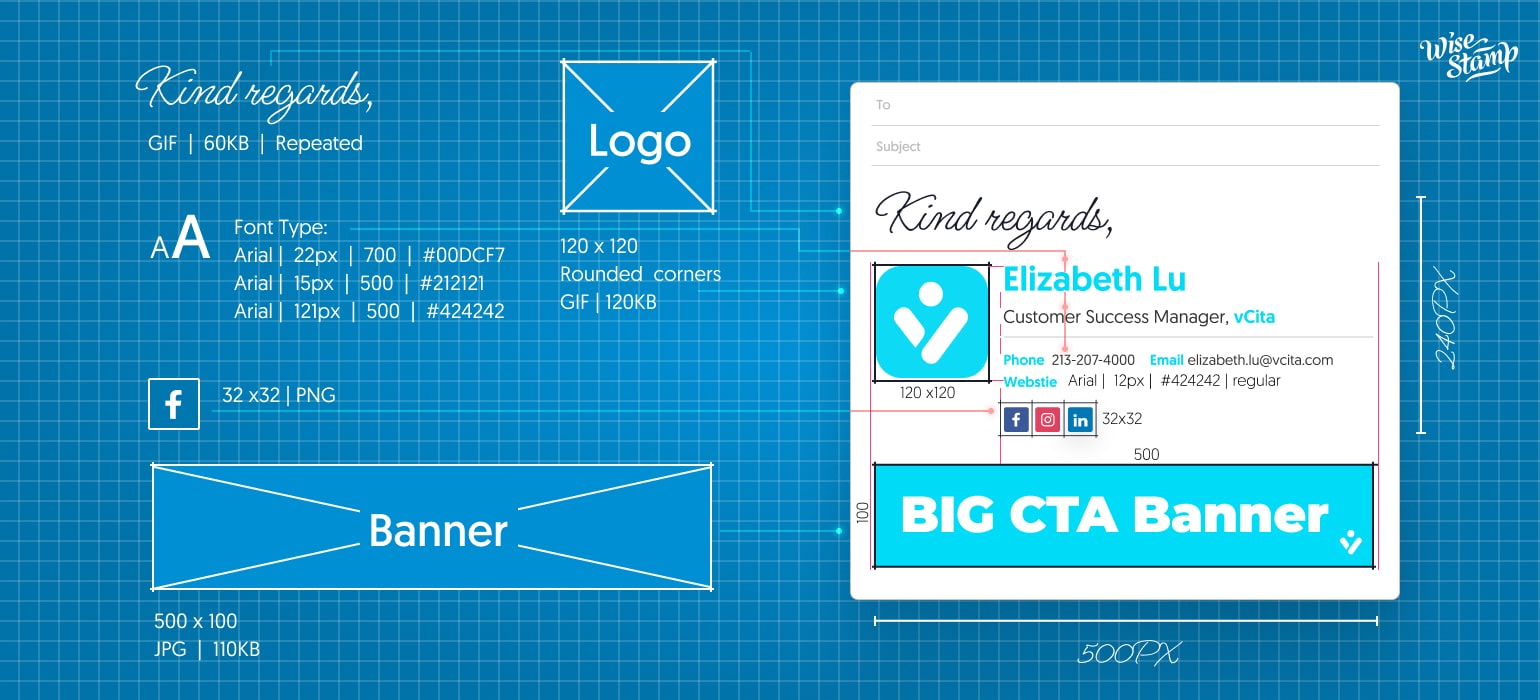Home / Email signature design / signature size
Email signature size & dimensions
Your email signature is an important part of your digital identity. It’s how you present yourself to the world, and it’s an integral part of your professional presence. But what is the ideal email signature size? What are the best practices for optimizing your email signature size?
Read on for our complete guide on email signature size and dimensions.

What is the best size for an email signature?
When we’re talking about email signature size, we’re referring to more than one set of dimensions. There are various things to consider when discussing email signature size: the dimensions of the entire signature, image size, image weight (file size), banner size, font size, etc. Each one of these deserves its own set of considerations, and some of those were elaborated on in our main email signature design guide and our logo size guide.
In this article, we’ll focus on the optimal dimensions (height and width) of an email signature as well as its optimal weight.
What’s on this page
Why does email signature size matter?
Email signatures are an important aspect of professional communication. However, it is important to keep the size of email signatures within an acceptable limit. This is because larger email signatures can cause several problems that can negatively impact the overall email experience.
For example, images that are too heavy might not download right away, or at all, on the recipients’ side, making your signature look odd.
The width of your signature will also determine how it’s going to look on different platforms. Different screen sizes play a role in the final outcome of your email signature. A signature that is too wide might not look as you intended it to look on a mobile screen.
Let’s break it down into 2 major components: file size and dimensions.

What does “file size” mean in email signatures?
Well, technically speaking, an email signature isn’t a file, therefore it doesn’t exactly have a “file size”. An email signature is basically a chunk of HTML script that is deciphered and presented by the email platform. That means the signature as a whole isn’t measured by weight (as in kilobytes) but actually by the number of characters.
The number of characters is obviously higher than the number of characters that are actually presented inside the signature. Just to illustrate – if I have a link in my signature that says: “Click Here to Subscribe”, its HTML back-end part will include not only the text but also the entire linked URL.
The number of HTML characters per email signature is in fact limited by the different email platforms, but the limitation is so high that it is highly unlikely that you will be able to go overboard with even the most elaborate signature imaginable.
As far as we know, Gmail limits the number of characters to 10,000, while Outlook settles for “only” 8,000. Cross that number, and your email signature might not be loaded or even directly rejected by the email provider. But this should cover far more than anything you need or want to add to your signature.
So in fact, when we’re talking about “file size” in email signatures, we’re referring to different files – usually, it’s the image files (logo, images, banners, etc.) that take up the most weight in your signature.
What is the ideal email signature “file size”?
The general rule for signature image file size is to keep it as small as possible. Ideally, the size should not exceed 100 KB. This is because larger emails can take longer to be processed by both servers and email clients, especially on mobile devices. Additionally, using a large email signature in a long email conversation can cause each subsequent email to become larger and clutter the communication process. Furthermore, mailboxes with a lot of space can still become overcrowded and take longer to search through, making it harder to find important emails.
Another reason to keep email signatures small is to avoid triggering spam filters. Spam filters are more likely to flag heavier emails as spam, so it is important to be careful with file size when creating email signatures. It is definitely possible to make an attractive email signature with all of your desired apps and add-ons while maintaining a small file size.
Preferable file formats
Each one of the more common file types used in graphic design has its own compression process, which makes its file size different.
For example, a JPG image will usually be smaller in size compared to PNG which contains more data. That doesn’t mean you should always go for the smallest file size available. We recommend experimenting with various file types and choosing the most suitable one for the specific images used. When saving JPG images, it is important to select the right compression rate or file quality to avoid an excessive size increase.
Finally, it is worth mentioning that animated gifs can contribute a lot to your email signature’s appeal, but you should be careful not to go over the top with the settings and end up with a huge email signature size. It is best to use animated gifs sparingly and keep their size within reasonable limits to avoid any issues with email processing and spam filters.

What are the ideal dimensions for an email signature?
An email signature should be kept relatively small, with dimensions of around 300-400px in width and 150-200px in height. More than 400px will not fit any mobile screen and will be scaled down accordingly. Although the height of an email signature is not constrained by screen size, it is nevertheless recommended to keep within this reasonable limit. This should provide enough space for all the contact information, marketing banners, logos, and disclaimers, while still fitting on devices with lower screen resolution. Also note that with these given dimensions there is no need for high-resolution, heavy images.
Your email signature template will vary according to your signature’s components. For aesthetic reasons, we recommend only using two columns in an email signature, but more columns are permitted. In any case, don’t use more than three columns. If you notice that the text in your email signature is overly long, we suggest you try to build it vertically, instead of horizontally.
Using overly-complex templates for email signatures is not a good idea, as it can make conversations difficult to follow. Instead, it is recommended to use different email signatures for new emails, replies, and forwards so that conversations can be easily followed. If you’re looking for signature inspiration, our email signature template library has plenty of free templates to choose from.

How to reduce your signature file size
There are a couple of ways in which you can reduce the overall weight of your email signature.
One way is to use links to images instead of actual image attachments. By uploading your signature images to your server and linking to them in your email signature, you can extremely reduce your signature’s file size and the images will simply be downloaded every time the email is opened. It is important to note however that linked images may be blocked by some email clients, which means that by default, in these cases, the recipient will only see a box instead of an image.
Another option to keep the size of the email signature low is to use image compression. You can use image editing software to reduce the file size of the images without sacrificing the quality. Additionally, you can set a maximum size for images in your email signature, for example, limiting the size of an image to no more than 50 KB. This will ensure that the images in your email signature are small enough to not impact the performance of your email, while still looking good.
It’s also important to note that not all email clients support images in the same way, so it’s always a good idea to test your email signature in different email clients to ensure that the images display correctly. By following these tips, you can effectively balance the use of images in your email signature with the need to keep the size of your email signature low, while still creating a professional and visually appealing signature.

Considering retina displays
Retina displays offer a clear and sharp display of text and images, and this is achieved by having a higher density of pixels per inch. With this in mind, you can optimize the images in your email signature for Retina displays by making them twice as wide and twice as tall as the original size. This way, the images will maintain their sharpness and clarity when viewed on Retina displays.
It’s crucial to note that simply making the images larger may not guarantee a correct display. For the best results, it’s important to exactly double the dimensions of the images to avoid any scaling issues. This will prevent images from becoming blurry or losing their sharpness on Retina displays.
Summary & conclusion
The size and dimensions of an email signature are important factors that contribute to a professional digital identity. To summarize what we’ve said in this article:
- Email signatures should be kept as small as possible, with images’ file size not exceeding 100 KB and dimensions around 300-400px in width and 150-200px in height.
- The preferred file format is JPG or PNG, but it’s important to be mindful of file size to avoid triggering spam filters.
- Image compression and using links instead of attachments can help reduce the file size.
- To optimize your email signature’s images for retina displays double their width and height.
It’s important to note that when you create your email signature in the WiseStamp editor, the images are automatically compressed to a desired size and then uploaded to a server to which the signature links, in order to have no effect on performance.
Follow these simple guidelines and your email signature will appear just fine in every recipient’s inbox.
- Email signature design guides
- Email signature design
- Email signature size
- Email signature colors
- Email signatures fonts
- Email signature logo size
- Email signature design examples
- Email signature examples
- Signature templates
- Email signature sign offs
- Email signature banner design
- Cool email signatures
- Personal email signature
- Basic email signatures
- Minimal email signatures
Free email signature generator
Popular features:
- 1-Click setup in your email
- Designed template options
- Add-ons for every need
- Email signature design guides
- Email signature design
- Email signature size
- Email signature colors
- Email signatures fonts
- Email signature logo size
- Email signature design examples
- Email signature examples
- Signature templates
- Email signature sign offs
- Email signature banner design
- Cool email signatures
- Personal email signature
- Basic email signatures
- Minimal email signatures
